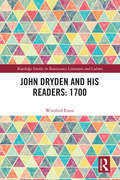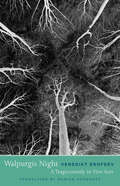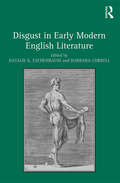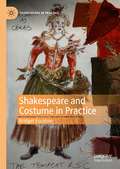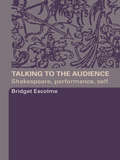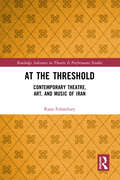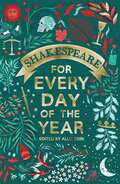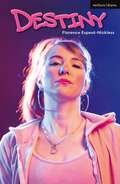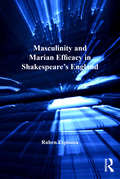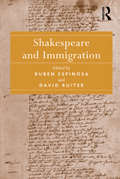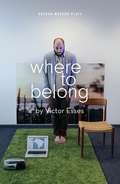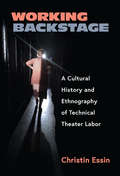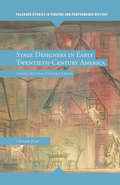- Table View
- List View
John Dryden and His Readers: 1700 (Routledge Studies in Renaissance Literature and Culture)
by Winifred ErnstDryden at the end of his life was admired, perhaps even beloved, by many in England, and his greatest skill over his long career—his controlled detachment—uniquely positioned him to write of both history and politics in 1700. His narrative poetry was popular among Whigs and Tories, women and men, Ancients and Moderns, and his imitations suggest historical connections between the War of the Roses, the Civil War, and the Revolution of 1688. All of these events combined easily in the minds of Dryden’s contemporaries, and his fables, fraught with conflicted loyalties and family strife not unlike a nation divided, may have caught and compelled his readers in a way that was different from other miscellanies: Dryden may have articulated in beautiful verse the emotions of many in the midst of enormous historical change. Fables is a pivotal cultural text urging national unity through its embrace of competing voices.
Walpurgis Night, or the Steps of the Commander (The Margellos World Republic of Letters)
by Venedikt ErofeevWalpurgis Night, by acclaimed Russian writer Venedikt Erofeev, is considered a classic in the playwright’s homeland. Erofeev’s dark and funny five-act satire of Soviet repression has been called the comic high-water mark of the Brezhnev era. Walpurgis Night dramatizes the outrageous trials of Lev Isakovich Gurevich, an alcoholic half-Jewish dissident poet confined by the state to a hospital for the insane. In “Ward 3”—a microcosm of repressive Soviet society—Gurevich deploys his brilliant wit and ingenuity to bedevil his jailers, defend his fellow inmates, protest his incarceration, and generally create mayhem, which ultimately leads to a tragedy of Shakespearean proportions.
Disgust in Early Modern English Literature
by Natalie K. Eschenbaum Barbara CorrellWhat is the role of disgust or revulsion in early modern English literature? How did early modern English subjects experience revulsion and how did writers represent it in poetry, plays, and prose? What does it mean when literature instructs, delights, and disgusts? This collection of essays looks at the treatment of disgust in texts by Spenser, Shakespeare, Donne, Jonson, Herrick, and others to demonstrate how disgust, perhaps more than other affects, gives us a more complex understanding of early modern culture. Dealing with descriptions of coagulated eye drainage, stinky leeks, and blood-filled fleas, among other sensational things, the essays focus on three kinds of disgusting encounters: sexual, cultural, and textual. Early modern English writers used disgust to explore sexual mores, describe encounters with foreign cultures, and manipulate their readers' responses. The essays in this collection show how writers deployed disgust to draw, and sometimes to upset, the boundaries that had previously defined acceptable and unacceptable behaviors, people, and literatures. Together they present the compelling argument that a critical understanding of early modern cultural perspectives requires careful attention to disgust.
Disgust in Early Modern English Literature
by Natalie K. Eschenbaum Barbara CorrellWhat is the role of disgust or revulsion in early modern English literature? How did early modern English subjects experience revulsion and how did writers represent it in poetry, plays, and prose? What does it mean when literature instructs, delights, and disgusts? This collection of essays looks at the treatment of disgust in texts by Spenser, Shakespeare, Donne, Jonson, Herrick, and others to demonstrate how disgust, perhaps more than other affects, gives us a more complex understanding of early modern culture. Dealing with descriptions of coagulated eye drainage, stinky leeks, and blood-filled fleas, among other sensational things, the essays focus on three kinds of disgusting encounters: sexual, cultural, and textual. Early modern English writers used disgust to explore sexual mores, describe encounters with foreign cultures, and manipulate their readers' responses. The essays in this collection show how writers deployed disgust to draw, and sometimes to upset, the boundaries that had previously defined acceptable and unacceptable behaviors, people, and literatures. Together they present the compelling argument that a critical understanding of early modern cultural perspectives requires careful attention to disgust.
Crisis, Representation and Resilience: Perspectives on Contemporary British Theatre(pdf) (Methuen Drama Engage)
by Clara Escoda Clare Wallace Enric Monforte José Ramón Prado-PérezA collection of incisive investigations into the ways that 21st-century British theatre works with - and through - crisis. It pays particular attention to the way in which writers and practitioners consider the ethical and social challenges of crisis. Anchored in an interdisciplinary approach that draws from sociology, cultural theory, feminism, performance and philosophy, the book brings multi-faceted ideas into dialogue with the diverse aesthetics, practices and themes of a range of theatrical work produced in Britain since 2005.Topics discussed include:AgeingAusterityGenderMigrancyMulticulturalismAestheticsCompanies discussed include: Theatre UncutLost DogCamden People's PeopleLungBrighton People's Theatre Phosphoros Theatre Playwrights discussed include: Jez Butterworth Caryl Churchill Tim Crouch Vivienne Franzmann James Graham debbie tucker green Ella Hickson Charlene James Lucy Kirkwood Simon Longman Cordelia Lynn Simon Stephens Jack Thorne Chris Thorpe Gloria Williams Building on recent publications in the area and engaging in dialogue with them, Crisis, Representation and Resilience considers how crisis is being re-thought and re-orientated through theatrical performance and the ways theatre invites us to respond to the many challenges of the contemporary times.
Shakespeare and Costume in Practice (Shakespeare in Practice)
by Bridget EscolmeWhat is the role of costume in Shakespeare production? Shakespeare and Costume in Practice argues that costume design choices are central not only to the creation of period setting and the actor’s work on character, but to the cultural, political, and psychological meanings that the theatre makes of Shakespeare. The book explores questions about what the first Hamlet looked like in his mourning cloak; how costumes for a Shakespeare comedy can reflect or critique the collective nostalgias a culture has for its past; how costume and casting work together to ask new questions about Shakespeare and race. Using production case studies of Hamlet, Much Ado About Nothing, and The Tempest, the book demonstrates that costume design can be a site of experimentation, playfulness, and transgression in the theatre – and that it can provoke audiences to think again about what power, race, and gender look like on the Shakespearean stage.
Talking to the Audience: Shakespeare, Performance, Self
by Bridget EscolmeThis unique study investigates the ways in which the staging convention of direct address - talking to the audience - can construct selfhood, for Shakespeare's characters. By focusing specifically on the relationship between performer and audience, Talking to the Audience examines what happens when the audience are in the presence of a dramatic figure who knows they are there. It is a book concerned with theatrical illusion; with the pleasures and disturbances of seeing 'characters' produced in the moment of performance.Through analysis of contemporary productions Talking to the Audience serves to demonstrate how the study of recent performance helps us to understand both Shakespeare's cultural moment and our own. Its exploration of how theory and practice can inform each other make this essential reading for all those studying Shakespeare in either a literary or theatrical context.
Talking to the Audience: Shakespeare, Performance, Self
by Bridget EscolmeThis unique study investigates the ways in which the staging convention of direct address - talking to the audience - can construct selfhood, for Shakespeare's characters. By focusing specifically on the relationship between performer and audience, Talking to the Audience examines what happens when the audience are in the presence of a dramatic figure who knows they are there. It is a book concerned with theatrical illusion; with the pleasures and disturbances of seeing 'characters' produced in the moment of performance.Through analysis of contemporary productions Talking to the Audience serves to demonstrate how the study of recent performance helps us to understand both Shakespeare's cultural moment and our own. Its exploration of how theory and practice can inform each other make this essential reading for all those studying Shakespeare in either a literary or theatrical context.
The Celebrated Hannah Cowley: Experiments in Dramatic Genre, 1776–1794 (Gender and Genre)
by Angela EscottHannah Cowley (1743–1809) was a very successful dramatist, and something of an eighteenth-century celebrity. New critical interest in the drama of this period has meant a resurgence of interest in Cowley’s writing and in the performance of her plays. This is the first substantial monograph study to examine Cowley’s life and work.
The Celebrated Hannah Cowley: Experiments in Dramatic Genre, 1776–1794 (Gender and Genre)
by Angela EscottHannah Cowley (1743–1809) was a very successful dramatist, and something of an eighteenth-century celebrity. New critical interest in the drama of this period has meant a resurgence of interest in Cowley’s writing and in the performance of her plays. This is the first substantial monograph study to examine Cowley’s life and work.
At the Threshold: Contemporary Theatre, Art, and Music of Iran (Routledge Advances in Theatre & Performance Studies)
by Rana EsfandiaryThis book examines the performance strategies used by contemporary Iranian artists and activists to reimagine “Iranian-ness” in the context of Iran’s local, regional, and global position. This study identifies the important social and political interventions made by theatrical and performance pieces, visual art, and electronic music that articulate and reformulate Iranian-ness by breaking away from fixed and constructed stereotypes projected on them by both the Islamic regime and Western power. This book explores the reception and context within which artworks become meaningful performative acts. Looking closely at the works of a notable female Iranian photographer, Shadi Ghadirian, in conjunction with the new generation of Iranian nonconformist artists/activists such as Tahmineh Monzavi and Hedieh Ahmadi; the visionary theatre productions of Ali Akbar Alizad; and radically untraditional sound/noise of the electronic music movement in Tehran, this book calls attention to the Iran-based artists who are tirelessly trying to raise awareness regarding the political violence imposed on Iranian identity at the legal (top-down) and everyday (bottom-up) levels. This volume will be of great interest to student and scholars in theatre and performance, photography, art, music, sociology, and politics.
At the Threshold: Contemporary Theatre, Art, and Music of Iran (Routledge Advances in Theatre & Performance Studies)
by Rana EsfandiaryThis book examines the performance strategies used by contemporary Iranian artists and activists to reimagine “Iranian-ness” in the context of Iran’s local, regional, and global position. This study identifies the important social and political interventions made by theatrical and performance pieces, visual art, and electronic music that articulate and reformulate Iranian-ness by breaking away from fixed and constructed stereotypes projected on them by both the Islamic regime and Western power. This book explores the reception and context within which artworks become meaningful performative acts. Looking closely at the works of a notable female Iranian photographer, Shadi Ghadirian, in conjunction with the new generation of Iranian nonconformist artists/activists such as Tahmineh Monzavi and Hedieh Ahmadi; the visionary theatre productions of Ali Akbar Alizad; and radically untraditional sound/noise of the electronic music movement in Tehran, this book calls attention to the Iran-based artists who are tirelessly trying to raise awareness regarding the political violence imposed on Iranian identity at the legal (top-down) and everyday (bottom-up) levels. This volume will be of great interest to student and scholars in theatre and performance, photography, art, music, sociology, and politics.
Shakespeare for Every Day of the Year
by Allie EsiriFrom Allie Esiri, editor of the bestselling A Poem for Every Day of the Year and A Poem for Every Night of the Year, comes this beautiful gift anthology of Shakespeare's works.William Shakespeare wrote at least 37 plays, 154 sonnets and a handful of longer poems and you can discover them all here. Each page of this unique collection contains an extract, which might be a famous poem, quote or scene, matched to the date. Allie Esiri's introductions give her readers a new window into the work, time and life of the greatest writer in the English language. Shakespeare for Every Day of the Year is perfect for reading or sharing and brings you Shakespeare’s best-known and best-loved classics alongside lesser known extracts. Esiri’s entertaining and insightful thoughts on each entry will fill your year with wonder, laughter, wisdom and wit.
Destiny (Modern Plays)
by Florence Espeut-NicklessThey're sayin I brought it on myself.Oh yeah, they've heard about me. Basically it must've been my fault cause I'm me, Destiny.Destiny dreams big. She dreams glamour. She's gonna be an MTV Base backing dancer, you watch. If J-Lo can make it outta the Bronx then Destiny can make it off the Hill Rise estate in Chippenham. She'sfearless, ferocious and up for the fight (she's had to be). Born below the breadline, she's desperate to see beyond the neighbourhood and find hope in hopelessness.This monologue follows the story of a teenage girl growing up on a rural Wiltshire council estate. After a big night out takes a turn for the worst, Destiny's life spirals out of control as she desperately tries to learn how to love and be loved. Florence Espeut-Nickless' debut play is a recipient of The Pleasance's 2021 National Partnerships Award with Bristol Old Vic FERMENT and was shortlisted for Theatre West's Write On Women Award.This edition was published to coincide with the run at the Edinburgh Festival Fringe 2022.
Destiny (Modern Plays)
by Florence Espeut-NicklessThey're sayin I brought it on myself.Oh yeah, they've heard about me. Basically it must've been my fault cause I'm me, Destiny.Destiny dreams big. She dreams glamour. She's gonna be an MTV Base backing dancer, you watch. If J-Lo can make it outta the Bronx then Destiny can make it off the Hill Rise estate in Chippenham. She'sfearless, ferocious and up for the fight (she's had to be). Born below the breadline, she's desperate to see beyond the neighbourhood and find hope in hopelessness.This monologue follows the story of a teenage girl growing up on a rural Wiltshire council estate. After a big night out takes a turn for the worst, Destiny's life spirals out of control as she desperately tries to learn how to love and be loved. Florence Espeut-Nickless' debut play is a recipient of The Pleasance's 2021 National Partnerships Award with Bristol Old Vic FERMENT and was shortlisted for Theatre West's Write On Women Award.This edition was published to coincide with the run at the Edinburgh Festival Fringe 2022.
Masculinity and Marian Efficacy in Shakespeare's England (Women and Gender in the Early Modern World)
by Ruben EspinosaMasculinity and Marian Efficacy in Shakespeare's England offers a new approach to evaluating the psychological 'loss' of the Virgin Mary in post-Reformation England by illustrating how, in the wake of Mary's demotion, re-inscriptions of her roles and meanings only proliferated, seizing hold of national imagination and resulting in new configurations of masculinity. The author surveys the early modern cultural and literary response to Mary's marginalization, and argues that Shakespeare employs both Roman Catholic and post-Reformation views of Marian strength not only to scrutinize cultural perceptions of masculinity, but also to offer his audience new avenues of exploring both religious and gendered subjectivity. By deploying Mary's symbolic valence to infuse certain characters, and dramatic situations with feminine potency, Espinosa analyzes how Shakespeare draws attention to the Virgin Mary as an alternative to an otherwise unilaterally masculine outlook on salvation and gendered identity formation.
Masculinity and Marian Efficacy in Shakespeare's England (Women and Gender in the Early Modern World)
by Ruben EspinosaMasculinity and Marian Efficacy in Shakespeare's England offers a new approach to evaluating the psychological 'loss' of the Virgin Mary in post-Reformation England by illustrating how, in the wake of Mary's demotion, re-inscriptions of her roles and meanings only proliferated, seizing hold of national imagination and resulting in new configurations of masculinity. The author surveys the early modern cultural and literary response to Mary's marginalization, and argues that Shakespeare employs both Roman Catholic and post-Reformation views of Marian strength not only to scrutinize cultural perceptions of masculinity, but also to offer his audience new avenues of exploring both religious and gendered subjectivity. By deploying Mary's symbolic valence to infuse certain characters, and dramatic situations with feminine potency, Espinosa analyzes how Shakespeare draws attention to the Virgin Mary as an alternative to an otherwise unilaterally masculine outlook on salvation and gendered identity formation.
Shakespeare and Immigration
by Ruben EspinosaShakespeare and Immigration critically examines the vital role of immigrants and aliens in Shakespeare's drama and culture. On the one hand, the essays in this collection interrogate how the massive influx of immigrants during the reign of Queen Elizabeth I influenced perceptions of English identity and gave rise to anxieties about homeland security in early modern England. On the other, they shed light on how our current concerns surrounding immigration shape our perception of the role of the alien in Shakespeare's work and expand the texts in new and relevant directions for a contemporary audience. The essays consider the immigrant experience; strangers and strangeness; values of hospitality in relationship to the foreigner; the idea of a host society; religious refuge and refugees; legal views of inclusion and exclusion; structures of xenophobia; and early modern homeland security. In doing so, this volume offers a variety of perspectives on the immigrant experience in Shakespearean drama and how the influential nature of the foreigner affects perceptions of community and identity; and, collection questions what is at stake in staging the anxieties and opportunities associated with foreigners. Ultimately, Shakespeare and Immigration offers the first sustained study of the significance of the immigrant and alien experience to our understanding of Shakespeare's work. By presenting a compilation of views that address Shakespeare's attention to the role of the foreigner, the volume constitutes a timely and relevant addition to studies of race, ethics, and identity in Shakespeare.
Shakespeare and Immigration
by Ruben EspinosaShakespeare and Immigration critically examines the vital role of immigrants and aliens in Shakespeare's drama and culture. On the one hand, the essays in this collection interrogate how the massive influx of immigrants during the reign of Queen Elizabeth I influenced perceptions of English identity and gave rise to anxieties about homeland security in early modern England. On the other, they shed light on how our current concerns surrounding immigration shape our perception of the role of the alien in Shakespeare's work and expand the texts in new and relevant directions for a contemporary audience. The essays consider the immigrant experience; strangers and strangeness; values of hospitality in relationship to the foreigner; the idea of a host society; religious refuge and refugees; legal views of inclusion and exclusion; structures of xenophobia; and early modern homeland security. In doing so, this volume offers a variety of perspectives on the immigrant experience in Shakespearean drama and how the influential nature of the foreigner affects perceptions of community and identity; and, collection questions what is at stake in staging the anxieties and opportunities associated with foreigners. Ultimately, Shakespeare and Immigration offers the first sustained study of the significance of the immigrant and alien experience to our understanding of Shakespeare's work. By presenting a compilation of views that address Shakespeare's attention to the role of the foreigner, the volume constitutes a timely and relevant addition to studies of race, ethics, and identity in Shakespeare.
The Art of Looking: How to Read Modern and Contemporary Art
by Lance EsplundA veteran art critic helps us make sense of modern and contemporary artThe landscape of contemporary art has changed dramatically during the last hundred years: from Malevich's 1915 painting of a single black square and Duchamp's 1917 signed porcelain urinal to Jackson Pollock's midcentury "drip" paintings; Chris Burden's "Shoot" (1971), in which the artist was voluntarily shot in the arm with a rifle; Urs Fischer's "You" (2007), a giant hole dug in the floor of a New York gallery; and the conceptual and performance art of today's Ai Weiwei and Marina Abramovic. The shifts have left the art-viewing public (understandably) perplexed.In The Art of Looking, renowned art critic Lance Esplund demonstrates that works of modern and contemporary art are not as indecipherable as they might seem. With patience, insight, and wit, Esplund guides us through the last century of art and empowers us to approach and appreciate it with new eyes. Eager to democratize genres that can feel inaccessible, Esplund encourages viewers to trust their own taste, guts, and common sense. The Art of Looking will open the eyes of viewers who think that recent art is obtuse, nonsensical, and irrelevant, as well as the eyes of those who believe that the art of the past has nothing to say to our present.
The Art of Looking: How to Read Modern and Contemporary Art
by Lance EsplundA veteran art critic helps us make sense of modern and contemporary art The landscape of contemporary art has changed dramatically during the last hundred years: from Malevich's 1915 painting of a single black square and Duchamp's 1917 signed porcelain urinal to Jackson Pollock's midcentury "drip" paintings; Chris Burden's "Shoot" (1971), in which the artist was voluntarily shot in the arm with a rifle; Urs Fischer's "You" (2007), a giant hole dug in the floor of a New York gallery; and the conceptual and performance art of today's Ai Weiwei and Marina Abramovic. The shifts have left the art-viewing public (understandably) perplexed. In The Art of Looking, renowned art critic Lance Esplund demonstrates that works of modern and contemporary art are not as indecipherable as they might seem. With patience, insight, and wit, Esplund guides us through the last century of art and empowers us to approach and appreciate it with new eyes. Eager to democratize genres that can feel inaccessible, Esplund encourages viewers to trust their own taste, guts, and common sense. The Art of Looking will open the eyes of viewers who think that recent art is obtuse, nonsensical, and irrelevant, as well as the eyes of those who believe that the art of the past has nothing to say to our present.
Where to Belong (Oberon Modern Plays)
by Victor EssesWhat makes a home for you? Victor Esses is Jewish-Lebanese, Brazilian, and gay. In 1975, Victor’s mother flees Lebanon as a refugee of the Civil War. In 2017, Victor visits Lebanon for the first time. In 2018, amidst the elections that will see Brazil choose a far-right president, he travels from London to São Paulo to show his partner the city of his childhood. Where to Belong is the tender, moving story of these journeys – an exploration of how to find your place in a rich and complex world of identities.
American ‘Unculture’ in French Drama: Homo Americanus and the Post-1960 French Resistance
by Les EssifA book about the role America plays in the French imagination, as it translates to the French stage. Informed by a rich variety of Western cultural scholarship, Essif examines two dozen post-1960 works representing some of the most innovative dramaturgy of the last half century, including works by Gatti, Obaldia, Cixous, Koltes, and Vinaver.
Working Backstage: A Cultural History and Ethnography of Technical Theater Labor
by Christin EssinWorking Backstage illuminates the work of New York City’s theater technicians, shining a light on the essential contributions of unionized stagehands, carpenters, electricians, sound engineers, properties artisans, wardrobe crews, makeup artists, and child guardians. Too-often dismissed or misunderstood as mere functionaries, these technicians are deeply engaged in creative problem-solving and perform collaborative, intricate choreographed work that parallels the performances of actors, singers, and dancers onstage. Although their contributions have fueled the Broadway machine, their contributions have been left out of most theater histories. Theater historian Christin Essin offers clear and evocative descriptions of this invaluable labor, based on her archival research and interviews with more than 100 backstage technicians, members of the New York locals of the International Alliance of Theatrical Stage Employees. A former theater technician herself, Essin provides readers with an insider’s view of the Broadway stage, from the suspended lighting bridge of electricians operating followspots for A Chorus Line; the automation deck where carpenters move the massive scenic towers for Newsies; the makeup process in the dressing room for The Lion King; the offstage wings of Matilda the Musical, where guardians guide child actors to entrances and exits. Working Backstage makes an significant contribution to theater studies and also to labor studies, exploring the politics of the unions that serve backstage professionals, protecting their rights and insuring safe working conditions. Illuminating the history of this typically hidden workforce, the book provides uncommon insights into the business of Broadway and its backstage working relationships among cast and crew members.
Stage Designers in Early Twentieth-Century America: Artists, Activists, Cultural Critics (Palgrave Studies in Theatre and Performance History)
by E. EssinBy casting designers as authors, cultural critics, activists, entrepreneurs, and global cartographers, Essin tells a story about scenic images on the page, stage, and beyond that helped American audiences see the everyday landscapes and exotic destinations from a modern perspective.
